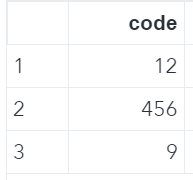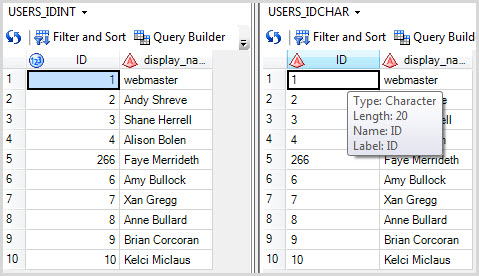
- #Numeric to character sas software#
- #Numeric to character sas code#
- #Numeric to character sas professional#
- #Numeric to character sas series#
SAS can map SQL Server uniqueidentifier values to character variables.

Your original source data may use a uniqueidentifier data type to identify rows. If you choose a bigint data type, be aware that very large bigint values can exceed the upper limit of a SAS numeric data type. Therefore, you may want a staging table column with an exact numeric data type, such as int or bigint, for this role. SAS packs routinely use a numeric indicator to track rows in a SAS data set. Nevertheless, you may find a primary key in the staging table useful for ordering your data for visual inspection before exporting them to SAS. The use of a primary key is strictly optional because SAS does not recognize SQL Server primary keys when data is transferred via. Use data types that have default translations from SQL Server as close as possible to those required by the SAS pack. Name the columns according to the variable names for the SAS pack for which you are preparing data.
#Numeric to character sas code#
The following script illustrates the type of code that you might use to generate a SQL Server table on which to base a SAS data set. Second, populate the columns with values. First, create a staging table with columns corresponding to the SAS pack variables. You can think of this part of the solution as a two-step process. SQL Server professionals will frequently need to populate this table from multiple relational tables in a SQL Server database. SAS analysis packs typically expect data from a single table. Create and Populate a Staging Table for SAS csv files to transfer data between SQL Server and SAS, data typing issues are not explicitly addressed in any ways besides the way SQL Server and SAS wizards handle the creation and reading of. The solution illustrated here takes advantage of SQL Server and SAS wizards to ready data and enable its transfer between SQL Server and SAS. In any event, when SQL Server professionals need to have their data interface with SAS packages, you should learn as much as possible about data typing and missing value representation and processing issues between SAS and SQL Server as your time permits. In some cases, these incompatibility issues may not matter, at other times, they will matter. SQL Server represents missing data values with NULL values, but SAS has a minimum of two ways of representing missing values: a period (.) for numeric missing values and a blank space (' ') for character missing values. Even the topic of representing and processing missing data values is substantially different between SQL Server and SAS.
#Numeric to character sas series#
This installment in the series closes with some ways of enriching the solution and resources for learning more about SAS. csv file with data values that are ready for transfer to SAS. Tip support materials include a script for creating a table and populating it with values for export from SQL Server to SAS as well as a. This first installment takes you from a SQL Server staging table for SAS through to its transfer to a SAS data set. In this first installment, you get a hands-on feel for the topic starting with coverage of the reasons and steps for creating a staging table in SQL Server for transfer to SAS. This tip is the first in a two-part series on presenting a simple set of techniques to handle interoperability between SQL Server and SAS with minimum hassle.
#Numeric to character sas software#
Since SQL Server and SAS are from different software vendors, newcomers to the task may find interoperability challenging.
#Numeric to character sas professional#
Therefore, if data you manage as a SQL Server professional has analytical applications in these or other areas, you may very well find yourself preparing data for SAS analytics professionals or even running SQL Server data through a SAS analytics package without support from SAS professionals.

SAS is a popular tool in such areas as healthcare and retail analytics.


 0 kommentar(er)
0 kommentar(er)
